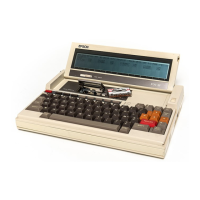REV.-A
In
the
above circuit,
the
Latch Pulse
(LP)
signal is supplied
to
the
Enable
Input
(EI)
terminal
of
the
first
(i.e.,
X1)
SED1120
driver. Once
the
X1
driver
is enabled (the internal
flipflop
is
set
ON)
with
a
single
LP
signal pulse,
the
subsequent
drivers
X2
through
X8
can be sequentially selected (or ena-
bled)
by
the
XECL signal.
2.8.3.2
Data
Transfer
Four data lines are
connected
to
each
SED1120
driver
and
four-bit
data is serially transferred one
bit
at
a time. The data are transferred
to
a
driver
and are
converted
to
parallel by an internal
shift
register. Fig.
2-79
outlines
the
timing
relationship
among
the
LCD
operation
signals.
LP
XECL~----------~
~
________
~
~~/-
____
~n~
______________
__
XSCL
mruuut1UUlfAlULJUUlYtuuuuuV)JUUULJUlJ11
~
16
pulses
SED1120
X1
X2
X7
X8
X1
Chip select
XSCL
DINO
60
~
________________
~
~
__________
~/~/
____
~fl~
____________
_
56
0
DIN1
~
________________
~ ~
______
~/~/
________
~rl~
________
__
57
61
DIN2
62
~
____________
~
~
__
-7)~
______
~n~
__
__
58
2
DIN3
63
~-7}
________
~n~
__
_
59
3
Fig.
2-79
LCD
Operation
Signal
Timing
16
pulses
of
the
data
strobing
signal XSCL are supplied
to
each
SED1120
driver. During each
of
these pulses, data
bits
DINO
through
DIN3 are strobed. These data
bits
correspond
to
particular
display
dots
and are transferred in sequence,
beginning
from
those
corresponding
to
the
segments
of
the
highest
numbers
as
shown
in
the
enlarged
timing
diagram in Fig.
2-79.
This
operation is repeated on all
the
SED1120
drives,
X1
through
X8,
to
display
a single horizontal
dot
line. The series
of
operations
needs
to
be repeated
64
times
to
display
all
dotons
the
entire LCD
panel.
2-77

